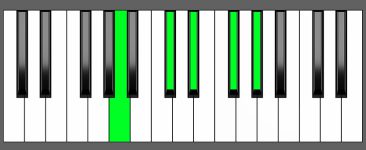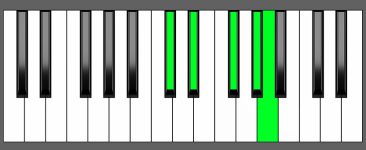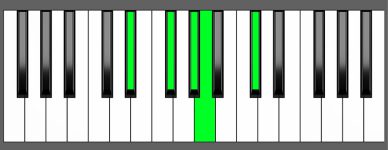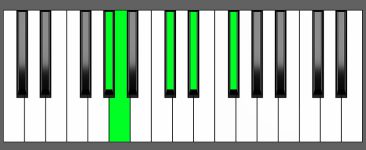Piano Diagram of Gbm6/9 in Root Position
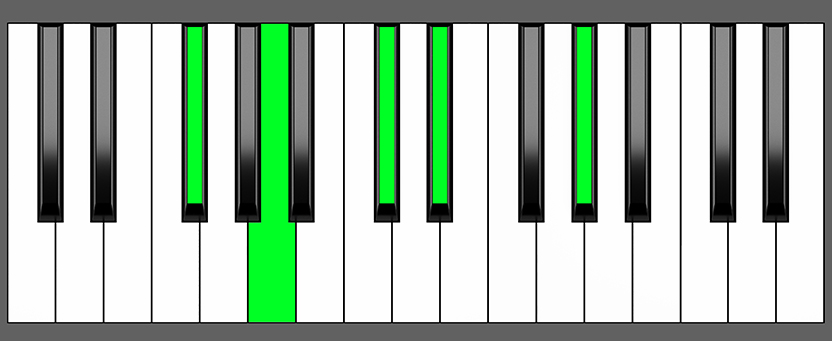
The Gbm6/9 chord is a minor chord based on the Gb key (Gb, Bbb, Db) but with additional major 6th (Eb) and major 9th (Ab) intervals. In this article, we will explore the music theory behind this chord in greater detail.
Structure of Gbm6/9
Notes |
|---|
| Gb, Bbb, Db, Eb, Ab |
Intervals |
|---|
| R, m3, 5, 6, 9 |
Gbm6/9 Chord Inversions
The Gbm6/9 chord has a total of 4 inversions:
| Root Position: | Gb | Bbb | Db | Eb | Ab |
| 1st Inversion: | Bbb | Db | Eb | Gb | Ab |
| 2nd Inversion: | Db | Eb | Gb | Ab | Bbb |
| 3rd Inversion: | Eb | Gb | Ab | Bbb | Db |
| 4th Inversion: | Ab | Bbb | Db | Eb | Gb |
Piano Keyboard Diagrams
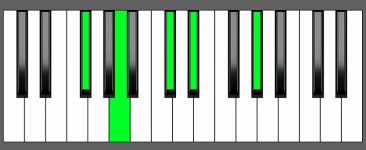
Chord Inversion on Piano
Chord inversions are a fundamental concept in music theory that explains how chords are constructed and fit into progressions. However, when discussing chord inversions on a piano keyboard, it’s essential to note that the diagrams used to show the notes in an inversion may not always be practical for playing.
In actual practice, pianists use different voicings and fingerings for chords, spreading the notes across various octaves and positions on the keyboard. This means that the basic shape of a chord’s inversions as depicted in diagrams might not always be the most effective way to play the chord on a piano keyboard.
How to play a Gbm6/9
To play the Gbm6/9 chord, you can start by playing the root note Gb with your left hand. Then, using your right hand, play the minor 3rd Bbb (equivalent to a natural A), the 6th Eb, and the 9th note Ab. This simplifies the Gbm6/9 chord to include only the root note, minor 3rd, major 6th, and 9th notes.
Gb + Bbb, Eb, Ab
Pianists often modify these chords for ease, excluding certain notes like the root or the 5th. Another approach is dividing the chord between hands, playing either full or partial chords in each hand. However, voicing chords on the piano is a nuanced topic that requires more explanation.
Keep in mind that these suggestions are general and may not suit every musical context.
Music Theory and Harmony of Gbm6/9
Building the Gbm6/9 Chord: Different Approaches
Starting from the Gb Major Scale
To build a minor 6/9 chord, you would typically include the root note, minor third, fifth, sixth, and ninth from a minor scale. However, when teaching this concept, it can be more effective to demonstrate its construction using a major scale. This is because a major scale better illustrates the relationship between intervals and their respective qualities.
So let’s take the Gb major scale:


Apply the formula R, m3, 5, 6, 9 to get a Gbm6/9 chord:
- Select the Root note, which is Gb.
- Pick the 3rd note, which is Bb, then lower it down by a half step to get the minor 3rd Bbb.
- Add the 5th note, which is Db, and include it as well.
- Now, add the 6th which is Eb.
- Lastly, include the 9th note of the Gb Major scale, which is an Ab.
by Combining Intervals
To build a minor 6/9 chord, one approach is to combine specific intervals, namely a minor 3rd, a major 3rd, a major 2nd (whole-tone), and a perfect 4th.
m3 + 3 + 2 + 4 = m6/9 Chords
In a Gbm6/9 chord, you can see that:
- Gb-Bbb forms a minor 3rd,
- Bbb-Db creates a major 3rd,
- Db-Eb makes a whole-tone interval,
- and Eb-Ab is a perfect 4th.
Stacking these intervals together creates a Gbm6/9 chord.
How to Use Gbm6/9 in a Chord Progression
Gbm6/9 chords can be used as a variation of minor chords. However, it’s important to understand that the major 6th and/or the 9th interval present in this chord may not always be a part of the scale being used.
on Natural minor Scales
| Minor Scales | i | ii | III | iv | v | VI | VII |
|---|---|---|---|---|---|---|---|
| Gb = F# | F# min7 ⇒ F#m6/9 = Gbm6/9 | G#m7b5 | A Maj7 | B min7 | C# min7 | D Maj7 | E7 |
| Db = C# | C# min7 | D#m7b5 | E Maj7 | F# min7 ⇒ F#m6/9 = Gbm6/9 | G# min7 | A Maj7 | B7 |
| Cb = B | B min7 | C#m7b5 | D Maj7 | E min7 | F# min7 ⇒ F#m6/9 = Gbm6/9 | G Maj7 | A7 |
- Non-diatonic Tonic chord in F# minor as F#m6/9
- Subdominant chord in C# minor as F#m6/9
- Non-diatonic Dominant chord in B minor as F#m6/9
on Major Scales
| Major Scales | I | ii | iii | IV | V | vi | vii |
|---|---|---|---|---|---|---|---|
| Fb = E | E Maj7 | F# min7 ⇒ F#m6/9 = Gbm6/9 | G# min7 | A Maj7 | B7 | C# min7 | D#m7b5 |
| Ebb = D | D Maj7 | E min7 | F# min7 ⇒ F#m6/9 = Gbm6/9 | G Maj7 | A7 | B min7 | C#m7b5 |
| Bbb = A | A Maj7 | B min7 | C# min7 | D Maj7 | E7 | F# min7 ⇒ F#m6/9 = Gbm6/9 | G#m7b5 |
- Supertonic chord in E Major as F#m6/9
- Non-diatonic Mediant chord in D Major as F#m6/9
- Non-diatonic Submediant chord in A Major as F#m6/9
Gbm6/9 in Gb minor (Non-Diatonic)
Check F#m6/9 in F# minor
Gbm6/9 in Db minor
Gbm6/9 in Cb minor (Non-Diatonic)
Gbm6/9 in Fb Major
Gbm6/9 in Ebb Major (Non-Diatonic)
Gbm6/9 in Bbb Major (Non-Diatonic)
Alternative Names for Gbm6/9 Chord
- Gb -6/9
- Solb-6/9
- Gb m6/9
- Gb m6/9th
- Gb min 6/9
- Gb m9(add6)
- Gb min9 add 6
- Gb minor 6th 9th
- Gb minor sixth-ninth
